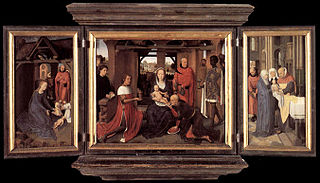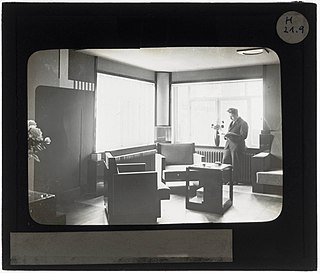
Hans Memling was a German-Flemish painter who worked in the tradition of Early Netherlandish painting. Born in the Middle Rhine region, he probably spent his childhood in Mainz. During his apprenticeship as a painter he moved to the Netherlands and spent time in the Brussels workshop of Rogier van der Weyden. In 1465 he was made a citizen of Bruges, where he became one of the leading artists and the master of a large workshop. A tax document from 1480 lists him among the wealthiest citizens. Memling's religious works often incorporated donor portraits of the clergymen, aristocrats, and burghers who were his patrons. These portraits built upon the styles which Memling learned in his youth.

St. Salvator's Cathedral, also known as the Cathedral of the Saviour and St. Donat, is the Roman Catholic cathedral of Bruges, Belgium. The cathedral is dedicated to the Verrezen Zaligmaker and Saint-Donatius of Reims.

Louis Delacenserie (1838–1909) was a Belgian architect from Bruges. The spelling of his name differs greatly; De la Censerie, Delasencerie, Dela Censerie or Dela Sencerie are the most common alternative forms. His father was a merchant and building contractor from Tournai.

The Royal Museum of Fine Arts Antwerp is a museum in Antwerp, Belgium, founded in 1810, that houses a collection of paintings, sculptures and drawings from the fourteenth to the twentieth centuries. This collection is representative of the artistic production and the taste of art enthusiasts in Antwerp, Belgium and the Northern and Southern Netherlands since the 15th century.

The Gruuthuse manuscript is a medieval compilation, the oldest core of which is dated about 1395, while the youngest unfinished contributions date from around 1408. The manuscript is the only known source for a large number of Middle Dutch texts.

Lancelot Blondeel, also Lanceloot, was a Flemish artist active in Bruges. He worked as a painter, architect, city planner, surveyor and cartographer, and designed sculptures, tapestries and jewelry.

AZ Groeninge is a large teaching hospital, affiliated with the Flemish KU Leuven Hospital network, in Kortrijk, West Flanders, Belgium. The hospital is the result of a merger of four hospitals in Kortrijk and is in number of beds, in its current form, the fifth largest hospital system in Belgium. The new 1000+ hospital bed facility at the Kennedylaan, opened in 2017, is one of the largest hospital sites in Belgium. In 2023 Newsweek ranked az groeninge 6th best hospital in Belgium and first non-academic hospital.

The Donne Triptych is a hinged-triptych altarpiece by the Early Netherlandish painter Hans Memling. The painting was created around 1478 for the soldier, courtier and diplomat Sir John Donne. The triptych comprises three panels that include five individual paintings. The central interior panel depicts the Virgin and Child, donor portraits of Sir John Donne, the patron, along with his wife and daughter, as well as Saint Catherine of Alexandria and Saint Barbra, The two double-sided wings include images of Saint John the Baptist, Saint John the Evangelist on the interior sides of the wings, and Saint Christopher and Saint Anthony Abbot on the two exteriors of the wings.

The Shrine of St. Ursula is a carved and gilded wooden reliquary containing oil on panel inserts by Hans Memling. Dating to c. 1489, it is housed in the Hans Memling Museum in the Old St. John's Hospital (Sint-Janshospitaal), Bruges, in the Flemish Region of modern-day Belgium.
Till-Holger Borchert is a German art historian and writer specialising in 14th and 15th-century art. He has been the chief curator of the Groeningemuseum and Arentshuis museums in Bruges, Belgium, between 2003 and 2014. In December 2014, he was appointed as director of the Municipal Museums in Bruges. In this role he initiated a radical reorganisation of the institution and laid the foundation for the renewal of infrastructure like the ticketing facility of the Gruuthusemuseum, a new storage, and the exhibition park BRUSK designed by architect Paul Robbrecht. In November 2021 he was appointed as new director of the Suermondt Ludwig Museum in Aachen, a position he resumed in April 2022.

Bruges is the capital and largest city of the province of West Flanders, in the Flemish Region of Belgium. It is in the northwest of the country, and is the sixth most populous city in the country.

The Exposition des primitifs flamands à Bruges was an art exhibition of paintings by the so-called Flemish Primitives held in the Provinciaal Hof in Bruges between 15 June and 5 October 1902.

The Mystic Marriage of St. Catherine is a c. 1480 oil-on-oak painting by the Early Netherlandish painter Hans Memling, now in the Metropolitan Museum of Art, New York. The Virgin Mary sits on a throne in a garden holding the Child Jesus in her lap. Mother and child are flanked by angels playing musical instruments, with St Catherine of Alexandria to the left opposite St Barbara on the right. The male figure standing slightly behind the celestial group presumably commissioned the painting as a devotional donor portrait.

Male Castle, Bruges. A community of the Canonesses Regular of the Holy Sepulchre. It originated in Bruges in the 11th century, and between 1954 and 2013 was settled in Male Castle in Male, Sint-Kruis, Bruges, West Flanders, Belgium.
The following is a timeline of the history of the municipality of Bruges, Belgium.

The Adriaan Reins Altarpiece is a three-panel 1480 altarpiece, painted by Hans Memling for brother Adriaan Reins of the Old St. John's Hospital in Bruges. It still hangs there as part of the collection of the Memlingmuseum.

The Jan Floreins Altarpiece or Triptych of Jan Floreins is a 1479 three-panel altarpiece, painted by Hans Memling for brother Jan Floreins of the Oud Sint-Janshospitaal in Bruges, where it still hangs as part of the collection of the Memlingmuseum.
Dirk de Vos is a Belgian art historian specialising in medieval art. He was the curator of the Groeningemuseum in Bruges.

Eleonora Verbeke (1713–1786) was a nun and apothecary at the Sint-Janshospitaal in Bruges, West Flanders, Belgium. She was a co-author of the Winckelbouck, in which, from 1751, she described all her medical recipes. Everyday recipes were also noted. She wrote in Dutch but also made use of the Bruges dialect.

Hubrecht (Huib) Hoste was a Belgian architect, designer and urban planner. He is considered the pioneer of modern architecture in Belgium.


















